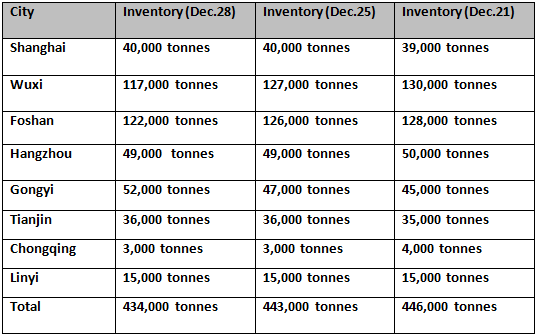

On Thursday, December 28, China's social inventories of aluminium ingot hit a new low for the year, standing at 434,000 tonnes. Compared to Monday, December 25, the inventories registered a fall of 9,000 tonnes, while from the previous week, December 21, the inventories stood 12,000 tonnes lower.
The chart below indicates the current status of primary aluminium inventories across China.
{alcircleadd}
The Shanghai Metals Market showed that on an annual basis, the inventories encountered a fall of 59,000 tonnes. The decline happened due to the lower arrivals of stocks in the South and East China markets but was slightly offset by restricted purchases at the beginning of the week.
Inventories across provinces
In Wuxi, primary aluminium inventories plunged by 13,000 tonnes week-on-week to stand at 117,000 tonnes on December 28. In Foshan, aluminium ingot inventories decreased by 6,000 tonnes over a week, coming in at 122,000 tonnes, followed by a drop in Hangzhou and Chongqing by 1,000 tonnes to end the year at 49,000 tonnes and 3,000 tonnes, respectively.
However, the inventories in Gongyi experienced a hike this week by 7,000 tonnes to reach 52,000 tonnes. In Shanghai and Tianjin, inventories grew by 1,000 tonnes W-o-W to 40,000 tonnes and 36,000 tonnes, while that in Linyi remained restrained at 15,000 tonnes as of December 28.
Since mid-December, due to the aluminium ingot price hike, primary aluminium's supply and demand pattern was affected, increasing the goods available in the market. Thus, the decline in inventories this week was limited. SMM forecasts that there is further very little room for continued significant declines in inventories. The lowest level of domestic aluminium ingot social inventories is estimated to range between 400,000-450,000 tonnes at the end of the year. The inventories are also expected to begin rising from early January.
Responses








